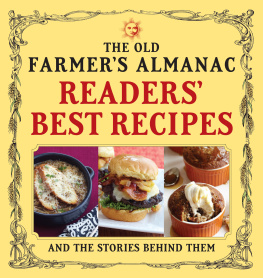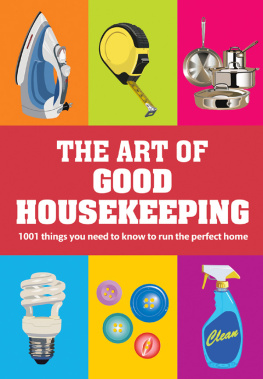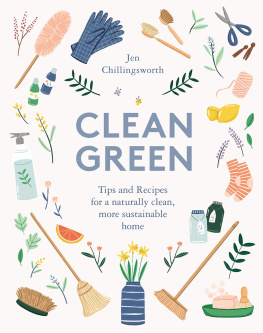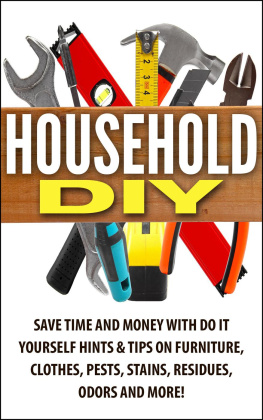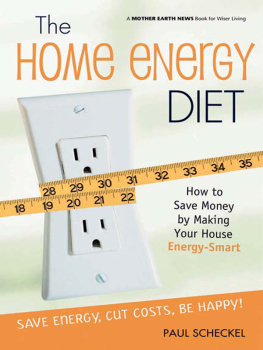INTRODUCTION
Keeping house is an art, a scienceand a tradition. But housekeeping today is getting more complex and more controversial despite technology that is designed to make life easier. As consumers, we confront daily decisions concerning the products we use (or avoid) in the home. Our store shelves are stocked with commercial cleaners that could pose serious health risks. Our grocery stores boast aisles of prepared foods designed to take the cooking out of mealtime. In general, the modern way of housekeeping is focused on instant gratification, less laborjust getting it done. The joy of creating a healthy hearth seems to be lost. We at BackHome magazine think its time to return to our roots and keep life simple. Its time to revisit age-old, effective, low-cost ways to clean the home, prepare food, entertain friends and family, garden and preserve produce, celebrate holidays, and organize our homes and lives. We can save a significant amount of money by going back to the basics, and in turn, well reduce our environmental impact.

The concept of sustainability that has developed so much groundswell in recent years is not a brand-new idea. In the country, we have always found ways to maximize the useful life of our resources, reduce our reliance on energy, and become more self-reliant. And today, we continue to find ways to reuse, replenish, reinventto do more with less, to live richer by spending little. Sound impossible? Actually, generations of country dwellers and our contributors at BackHome share just how easy it can be to live a self-reliant, budget-friendly lifestyle. The ultimate reward: greater independence! When you cut more clutter and cost out of life, you find room to really live.
This book is chock-full of how-to projects, recipes, and instructions for living a simpler, cleaner life. (Your wallet will thank you for it.) Our seasoned veterans provide practical, doable ideas youll want to try. Its time to get back to tradition of keeping house, appreciate the art, and recognize proven, old-fashioned science that is safe, effective...and fun!
Now, its time to get your hands dirty! (And we bet youll find a new hobby in these pages while youre at it.) Lets get back to the basics and focus on whats important. That is the objective of this book. Now its up to you to press reset in your own home and live a simpler, more fulfilling life. Were eager to help you on that journey.
Sincerely,
The editors and contributors of BackHome

CHAPTER 1
KITCHEN AND PANTRY

The kitchen is the heart of the home. Its the hub of activity, where we cook, dine, socialize, workits where everyone gathers. We want that area to be clean, well organized, and free of contamination and health risks. This chapter contains the basics: toxin-free cleaning, smart space-saving organization, and tips on tools and utensils. Here, youll discover a world of money- (and energy-) saving ideas.

Avoid Toxins in Home Cleaners
Cost savings
About $25 saved by not having to purchase many cleaning, laundering, and toiletry items
Benefits
Improved indoor air quality
BackHomecontributor Shawn Dell Joyce brings in-depth focus to issues that connect us with our environment. Here, she hits home with a discussion of healthy, cost-effective household cleaner alternatives.
Ever notice how most cleaning products do not have ingredient lists? These common products are not required by law to list whats inside, even though some might contain chemicals that can harm you and the environment. In fact, of the 80,000 chemical compounds currently used in commercial cleaning products, only one-half percent have been tested for cancer-causing ingredients, according to Naturally Clean author Jeffrey Hollender.
We breathe these chemicals while we clean, drink them in polluted water, and absorb them through our skin. (Kind of scary, isnt it?) The U.S. Environmental Protection Agency (EPA) estimates that we are exposed to air pollutants two to five times more indoors than outdoors. This is mainly because these pollutants are concentrated when we use them indoors with little ventilation.
To protect yourself and your indoor air quality, phase out household cleaning products containing any of the ingredients listed in Common Household Toxins on page 11.
Before we became so reliant on chemistry, we used to clean our homes with natural cleansers. Try restocking your cleaning cabinet with these natural and nontoxic alternatives:
Pure vegetable or castile soap can replace shampoo, hand soap, and dish detergent.
Vinegar cuts grease and removes mildew, is a brick/stone cleaner, and cleans windows without streaking. Drizzle it on top of a little baking soda to scour a toilet or clean a dirty bathtub.
Baking soda (sodium bicarbonate) is a gentle abrasive powder for stovetops and shiny surfaces. It will extinguish a grease fire, deodorize your home, and can be used as toothpaste and deodorant.
Borax is a mineral that can inhibit mildew, remove stains, work with soap as a laundry detergent, and be mixed with sugar to kill cockroaches.
Cornstarch makes an excellent window cleaner or furniture polish when diluted with water. In its powder form, use it to shampoo carpets and starch clothes.
Washing soda is a heavy-duty cleaner for burned pans, grills, and ovens.
Here are a few recipes with which to replace common household cleaners with inexpensive nontoxic alternatives.
All-purpose cleaner: Dissolve 4 tablespoons (55 g) of baking soda in 1 quart (946 ml) of warm water.
Spray disinfectant: Fill an empty spray bottle halfway with isopropyl alcohol and fill it up with water.
Drain cleaner: Pour 1/2 cup of baking soda (110 g) down the drain followed by 1/2 cup (120 ml) of vinegar. Do not try this if you have already used a commercial drain opener, because the fumes would be toxic.


